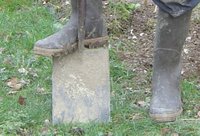
“A good plan today is better than a perfect plan tomorrow” (Proverb)
Back on 24th November I was telling you where we'd got to on our permaculture planning, which wasn't far and one of the reasons I stated was that it seemed so difficult and complicated added to which one has to make decisions too! We've got three plans on the go, one for the holiday gite garden, one for our woodland and one for the larger site our house sits on (which also contains the gite). We'd completed base maps (see my blogs of October 27th and November 12th) and needed to do a site survey and questionnaire before moving onto the actual designing bit.
The gite garden is a good starting point as it’s the smallest area. It’s practice and experience for us, and we hope that it will provide a working example of small-space permaculture to suggest possibilities to anyone holidaying in our gite who likes what we’re doing but is concerned that what we’re trying to do over 2 acres couldn’t apply to their terraced house city garden back home. We must also keep in mind that people staying with us aren’t necessarily going to be interested in permaculture at all and so it needs, first and foremost (as the income is important to us) to be a relaxing, aesthetic and aromatic place of leisure and rest. The site survey seemed to us to be a continuation of the base map and many of the questions that it poses were already on the map, especially as ours is such a small space. That said two things we haven’t done (and are covered in this stage) are monitor sun and shade (which will have an impact on choices of plants and their positioning) and a proper soil survey.
Impatiently (no change there, then!) we moved onto to the design questionnaire. As this is our own property, we’re both designer and client.
Our basic aims are as above and so to the “wants”: we first have to consider present outputs and divide what we want to get rid of from what we want to keep. Next is the list of produce for the home, produce for sale and other useful outputs, which would include such intangibles a beauty and leisure use. An order of priority is useful at this stage (invaluable in our experience) and then one has to honestly consider available resources in terms of time, skills and, of course, money.
Over the next few blogs, I’ll tell you how this relates to the gite garden and tell you what happened when we actually got the spades out.
